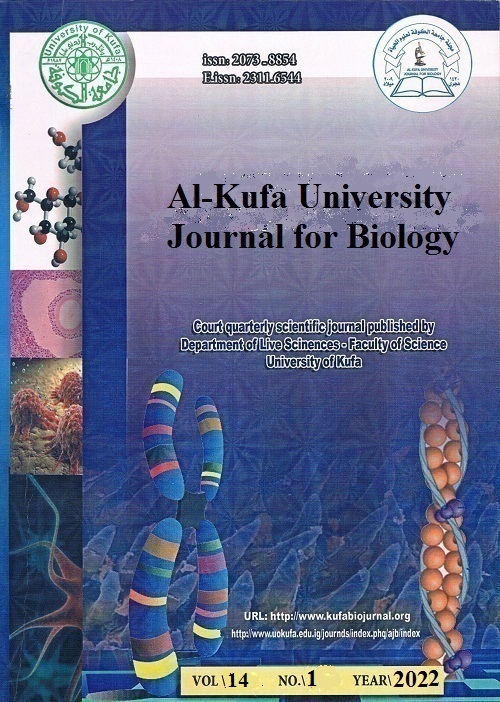Estimation of Cytokines (IL-1&IL-22) in Wounds Infected with Pseudomonas aeruginosa in Albino Rat
DOI:
https://doi.org/10.36320/ajb/v14.i1.11749Keywords:
IL-1, IL-22, Wound infection, Pseudomonas aeruginosaAbstract
Wound infection is described as the occurrence of microorganisms in sufficient numbers or with sufficient virulence in a wound environment to stimulate an immune system response locally, systemically, or both. The present study focused on assessing the immune response by measuring cytokine levels ( IL-1, IL-22 ) in the serum of rats that induced wound infected with Pseudomonas aeruginosa. Thirty-six female Albino rats were used, divided into 3 groups GI (infected group), GII (wound without infection group), and GIII (healthy control group). An excision wound was made on the rat’s back and then contaminated the wound region with a bacterial solution that contain 2.5 ×106 CFU of P. aeruginosa. Following that, blood samples were taken at predetermined time periods (24 hours, 48 hours, and 72 hours) following infection to evaluate immunological response during wound infection. We found that the cytokines (IL-1) were detectable at all times ( 24, 48, 72 ) hours and observed in all studied groups while a significantly elevated level of IL-22 ( 0.77 ± 0.08 ) pg/ml was recorded in 24 hours in the infection group and then decreased at 72 hours.
Downloads
References
Khalili, S., Khorasani, S. N., Saadatkish, N., & Khoshakhlagh, K. (2016). Characterization of gelatin/cellulose acetate nanofibrous scaffolds: Prediction and optimization by response surface methodology and artificial neural networks. Polymer Science Series A, 58(3), 399-408. https://doi.org/10.1134/S0965545X16030093 DOI: https://doi.org/10.1134/S0965545X16030093
Singer, A. J., & Clark, R. A. (1999). Cutaneous wound healing. New England journal of medicine, 341(10), 738-746. https://www.nejm.org/doi/full/10.1056/NEJM199909023411006 DOI: https://doi.org/10.1056/NEJM199909023411006
Böttcher-Haberzeth, S., Biedermann, T., & Reichmann, E. (2010). Tissue engineering of skin. Burns, 36(4), 450-460. https://www.sciencedirect.com/science/article/pii/S0305417909004951 DOI: https://doi.org/10.1016/j.burns.2009.08.016
Maharjan, N., & Mahawal, B. S. (2020). Bacteriological profile of wound infection and antibiotic susceptibility pattern of various isolates in a tertiary care center. Journal of Lumbini Medical College, 8(2), 218-224. https://doi.org/10.22502/jlmc.v8i2.367
Wu, M., & Li, X. (2015). Klebsiella pneumoniae and Pseudomonas aeruginosa. In Molecular medical microbiology (pp. 1547-1564). Academic Press. https://doi.org/10.1016/B978-0-12-397169-2.00087-1 DOI: https://doi.org/10.1016/B978-0-12-397169-2.00087-1
Al-Azzawi, M. K., Makharmash, J. H., & Al-Malkey, N. K. (2020). The effect of Lactobacillus species on the Pseudomonas aeruginosa. Drug Invention Today, 14(2).
Migiyama, Y., Yanagihara, K., Kaku, N., Harada, Y., Yamada, K., Nagaoka, K., ... & Kohno, S. (2016). Pseudomonas aeruginosa bacteremia among immunocompetent and immunocompromised patients: relation to initial antibiotic therapy and survival. Japanese journal of infectious diseases, 69(2), 91-96. https://doi.org/10.7883/yoken.JJID.2014.573 DOI: https://doi.org/10.7883/yoken.JJID.2014.573
Strbo, N., Yin, N., & Stojadinovic, O. (2014). Innate and adaptive immune responses in wound epithelialization. Advances in wound care, 3(7), 492-501. https://doi.org/10.1089/wound.2012.0435 DOI: https://doi.org/10.1089/wound.2012.0435
Fahey, E., & Doyle, S. L. (2019). IL-1 family cytokine regulation of vascular permeability and angiogenesis. Frontiers in Immunology, 10, 1426. https://doi.org/10.3389/fimmu.2019.01426 DOI: https://doi.org/10.3389/fimmu.2019.01426
Al-Jebouri, M. M., & Al-Mahmood, B. Y. R. (2019). Estimation of Cytokines Involved in Acute-Phase Wound Infection with Reference to Residence Time of Patients in Hospitals. Modern Research in Inflammation, 8(01), 1. https://doi.org/10.4236/mri.2019.81001 DOI: https://doi.org/10.4236/mri.2019.81001
Avitabile, S., Odorisio, T., Madonna, S., Eyerich, S., Guerra, L., Eyerich, K., ... & Cianfarani, F. (2015). Interleukin-22 promotes wound repair in diabetes by improving keratinocyte pro-healing functions. Journal of Investigative Dermatology, 135(11), 2862-2870. https://doi.org/10.1038/jid.2015.278
Maura, D., Bandyopadhaya, A., & Rahme, L. G. (2018). Animal models for Pseudomonas aeruginosa quorum sensing studies. In Quorum Sensing (pp. 227-241). Humana Press, New York, NY. https://doi.org/10.1007/978-1-4939-7309-5_18 DOI: https://doi.org/10.1007/978-1-4939-7309-5_18
de Moura Estevão, L. R., Cassini-Vieira, P., Leite, A. G. B., de Carvalho Bulhões, A. A. V., da Silva Barcelos, L., & Evêncio-Neto, J. (2019). Morphological evaluation of wound healing events in the excisional wound healing model in rats. Bio-protocol, 9(13). http://www.bio-protocol.org/e3285 DOI: https://doi.org/10.21769/BioProtoc.3285
Schaudinn, C., Dittmann, C., Jurisch, J., Laue, M., Günday-Türeli, N., Blume-Peytavi, U., ... & Rancan, F. (2017). Development, standardization and testing of a bacterial wound infection model based on ex vivo human skin. PLoS One, 12(11), e0186946. https://doi.org/10.1371/journal.pone.0186946 DOI: https://doi.org/10.1371/journal.pone.0186946
Utariani, A., Rahardjo, E., & Perdanakusuma, D. S. (2020). Effects of albumin infusion on serum levels of albumin, proinflammatory cytokines (TNF-α, IL-1, and IL-6), CRP, and MMP-8; tissue expression of EGRF, ERK1, ERK2, TGF-β, collagen, and MMP-8; and wound healing in Sprague Dawley rats. International journal of inflammation, 2020. https://doi.org/10.1155/2020/3254017 DOI: https://doi.org/10.1155/2020/3254017
Hughes, O., MacQuhae, F., Rakosi, A., Herskovitz, I., & Kirsner, R. S. (2017). Stress and wound healing. In Stress and Skin Disorders (pp. 185-207). Springer, Cham. https://doi.org/10.1007/978-3-319-46352-0_19 DOI: https://doi.org/10.1007/978-3-319-46352-0_19
Barthelemy, A., Sencio, V., Soulard, D., Deruyter, L., Faveeuw, C., Le Goffic, R., & Trottein, F. (2018). Interleukin-22 immunotherapy during severe influenza enhances lung tissue integrity and reduces secondary bacterial systemic invasion. Infection and immunity, 86(7), e00706-17. https://doi.org/10.1128/IAI.00706-17 DOI: https://doi.org/10.1128/IAI.00706-17
Guillon, A., Brea, D., Morello, E., Tang, A., Jouan, Y., Ramphal, R., ... & Si-Tahar, M. (2017). Pseudomonas aeruginosa proteolytically alters the interleukin 22-dependent lung mucosal defense. Virulence, 8(6), 810-820. https://doi.org/10.1080/21505594.2016.1253658 DOI: https://doi.org/10.1080/21505594.2016.1253658
Avitabile, S., Odorisio, T., Madonna, S., Eyerich, S., Guerra, L., Eyerich, K., ... & Cianfarani, F. (2015). Interleukin-22 promotes wound repair in diabetes by improving keratinocyte pro-healing functions. Journal of Investigative Dermatology, 135(11), 2862-2870. https://doi.org/10.1038/jid.2015.278 DOI: https://doi.org/10.1038/jid.2015.278
Downloads
Published
How to Cite
Issue
Section
License
Copyright (c) 2022 Hawra'a Ala'a Hassen , Kifah Fadhil Hassoon

This work is licensed under a Creative Commons Attribution 4.0 International License.
which allows users to copy, create extracts, abstracts, and new works from the Article, alter and revise the Article, and make commercial use of the Article (including reuse and/or resale of the Article by commercial entities), provided the user gives appropriate credit (with a link to the formal publication through the relevant DOI), provides a link to the license, indicates if changes were made and the licensor is not represented as endorsing the use made of the work.












